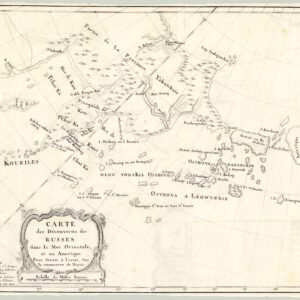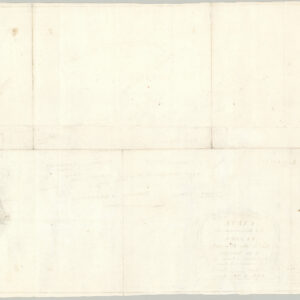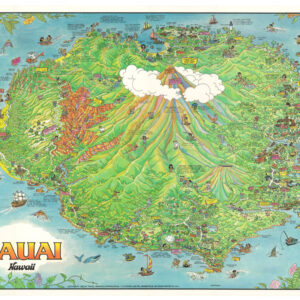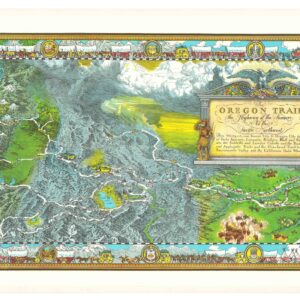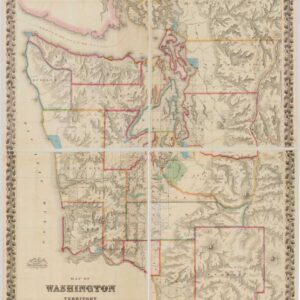History’s second mapping of Hawaii.
Carte des Parties des Îles Sandwich & Carte des Îles Sandwich.
$1,600
In stock
Description
This exemplary double chart depicts the island cluster of Hawaii, as surveyed by Comte Le Perouse and his team on their legendary expedition to the Pacific (1785-88).
While constituting a single sheet, it is two distinct maps. The upper map offers a more focused look at the eastern islands (Hawaii, Maui, Molokai, and the east tip of O’ahu). It was here, in Maui, that the Comte de la Perouse and his crew made their first landfall. The lower map provides a full view of the archipelago, drawing partly from Cook’s initial mapping seven years earlier.
Both maps are exceptionally well executed, revealing the prestige associated with the publication of the La Perouse expeditionary account. In addition to delineating the route taken by the two French frigates, the map includes gorgeous details of the volcanic topography. These brand-new details are only made even more exciting by the vivacious hand-coloring. Toponyms are limited to the names of the islands themselves, reflecting that we are indeed in the very first stages of Hawaiian cartography.
Notably, the map fixes Hawaii’s position in the vast Pacific Ocean using detailed longitudinal and latitudinal graticules along the edges of both maps. Expanding on Cook’s nautical surveys, the maps include crucial fix points along the islands’ coastlines. By reusing these, new and better measurements could be taken, and these were far more readily compared to the published results from Cook’s Third Voyage.
Context is Everything
The European discovery and initial charting of Hawaii (a.k.a. the Sandwich Isles) was accomplished by Captain James Cook during his Third Voyage in 1778, making La Perouse and his crew only the second European expedition in history to visit and map the archipelago. It is not strange that La Perouse mapmaker used Cook’s maps as a template (as noted in the maps’ subtitle). Cook named them the ‘Sandwich Islands ‘ in honor of his patron, the Earl of Sandwich. However, with Cook’s tragic demise in 1779, Henry Roberts, the expedition cartographer, failed to complete his task, leaving significant of the islands’ parts unexplored.
Inspired by Cook’s achievement, King Louis XVI launched his expedition to the Pacific, led by Jean-François de Galoup, the Comte de La Pérouse. Traveling aboard two frigates, the Boussole and L’Astrolabe, La Pérouse’s party disembarked on Maui, marking the first recorded European landing on this particular island. Sebastian Bernizet, La Pérouse’s cartographer, meticulously documented their discoveries, especially as they pertained to the central islands, and incorporated these details onto his maps. This explains why our sheet contains a more focused map of this part of the archipelago alongside the overview map.
Besides charting hitherto unknown regions of the world, La Perouse’s Pacific expedition is perhaps most famous for disappearing mysteriously in 1788. Today, we know that their disappearance – which included two ships and 225 officers, sailors, and scientists – was due to being shipwrecked on the reefs off Vanikoro. In 1826, an Irish captain named Peter Dillon acquired several swords on the Solomon Islands that the locals claimed had come from a nearby island called Vanikoro, where two large ships had broken up. Visiting the site, Dillon, and later Dumont d’Urville, discovered European anchors and other wreckage identified as belonging to L’Astrolabe. It would take until 1964 for the remains of the Boussole to be found on the same reefs.
Despite the tragic end to the La Perouse expedition, a significant part of their records were preserved because they had been stored in New South Wales (Australia) for transshipment back to France. By the end of the 18th century, French scholars could publish an extraordinary account, which included a series of ground-breaking maps from the Pacific. Neatline’s double map of Hawaii derives from this landmark publication in expedition literature.
Cartographer(s):
Jean François de Galaup, comte de Lapérouse (23 August 1741 – 1788 ca.) was a French Naval officer and explorer whose famous expedition vanished in Oceania. His naval career began when he entered the French Navy college in Brest at the age of fifteen. Over the years, he participated in various naval campaigns, among other things, earning the esteemed rank of Commodore for his victory over the English frigate ARIEL in the West Indies. He also played a significant role in the Battle of the Saintes and gained recognition by capturing two English forts along the coast of Hudson Bay.
In 1785, La Perouse was appointed to lead an expedition around the world by Louis XVI and his Secretary of the Navy, the Marquis de Castries. The aims of the expedition were quite ambitious, intending to sail and map regions such as Chile, Hawaii, Alaska, California, East Asia, Japan, Russia, Australia, and the South Pacific. The entire expedition vanished mysteriously after leaving New South Wales in March 1788. They were en route to New Caledonia, the Solomons, and the western and southern coasts of Australia. No member of the expedition was ever heard from again.
Condition Description
Lovely. Wide margins.
References
